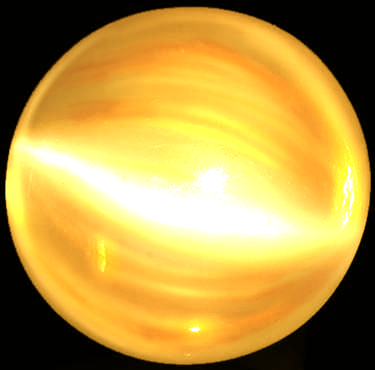Sunstone
A precious gemstone native to the sands of the Ekhmeni Desert, said in legends to be fragments of ancient sunlight preserved in stone. While known science has disproved the literal accuracy of those legends, the mesmerizing, sun-like luster of these amber-colored stones has made them highly prized throughout history. They are often considered sacred by the Ekhmeni as drops of the light-giving, life-giving and life-taking sun, and whenever not explicitly involved in ceremonies or the like, they are extremely common as accent pieces in jewelry and in decorations.
Properties
Material Characteristics
Sunstones are bright pale gold to amber-colored gemstones, often formed into round or oblong cabochons an inch long. Most specimens also include fine flecks--or sometimes streaks--of vivid orange, and the most valuable specimens also produce a band of milky yellow, glow-like luster in the light, said to be a captured sunbeam.
Physical & Chemical Properties
Sunstone is not a very hard gemstone--many other, more common gemstones and minerals such as quartz will scratch it. One could even easily scratch it with a common steel knife, it is so soft. As such, its use beyond the aesthetic, religious, and superstitious is limited. However, it has been quite common practice in the past and in modern Ekhmeni traditions to heat sunstone until it releases its unique aroma in a practice similar to the Mizuri traditional use of incenses. However, heating sunstone does, over time, harden it while fouling its color and luster, making it less useful for jewelry and decoration.
Geology & Geography
Sunstones are most commonly found in the deepest layers of sandstone in the Ekhmeni Desert. In past centuries, they were only readily found in the higher layers, but recent developments in mining technologies have made it easier to access the deeper, richer deposits.
History & Usage
Everyday use
The main place more common people would see sunstones used in everyday life is in the expensive jewelry available in specialty markets. Pendants on necklaces are the most common, especially pendants evoking more of the sun imagery to complement the sunstone itself.
Distribution
Trade & Market
Sunstones are widely considered to be luxury, high-status precious gemstones, and while at first that was mostly because they were thought to be exceedingly rare and hard to mine, nowadays that is mostly due to associations with traditions and with Ekhmeni nobility.
Type
Stone
Odor
When heated, sunstones give off a rusty, almost resinous smell
Color
Pale gold to rich amber with darker orange flecks
Remove these ads. Join the Worldbuilders Guild









